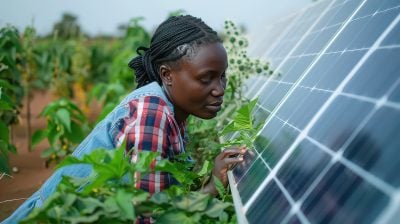According to the Kenya National Bureau of Statistics (KNBS) agriculture accounts for 27% of the country’s GDP. The Kenya Agricultural Research Institute (KARI) says that 45% of government revenue is derived from agriculture and the sector contributes more than 50% of export earnings. Over 60% of Kenya’s workers are employed in agricultural establishments making the sector the largest employer in Kenya: 75% of Kenya’s industrial raw materials is sourced from the agriculture sector. In 2012 agriculture grew by 3.8% as compared to 1.5% in 2011.
Agriculture has dominated Kenya’s economy going back to the East African Protectorate and Kenya Colony days. For the first 50 years of colonialism agriculture was the main economic activity. Today after 50 years of independence, agriculture is still king.
Kenya’s bulk agricultural exports include tea, coffee, cut flowers, rice, milk, horticulture, nuts and beef. The main market for Kenyan agricultural produce is the European Union bloc and the Middle East.
Members of the Fresh Produce Exporters Association of Kenya (FPEAK) form an increasingly important plank in the country’s economy. Fresh fruits, flowers and vegetables are airlifted daily to their international markets. The flowers include carnations, roses, statice, lilies, hypericum and alstromeria.
Horticultural products include chillies, karella, aubergines, French beans and snow peas. Mangoes, pineapples, avocados and passion fruit lead the fresh fruits list.
In 2013, tea export earnings totalled $1.4bn. Kenya which is one of the largest tea exporters in the world, has over 50 varieties of tea. Kenya’s tea is popular worldwide because it gets a maximum of 12 hours of sunlight each day, is grown along the equator and is free of pests and diseases.
Production of tea in Kenya is undertaken by large-scale tea growers and smallholder farmers. There are over half a million smallholder tea farmers in Kenya according to the Tea Board of Kenya. Kenya’s main tea markets include, Egypt, Pakistan, the UK, Afghanistan and the UAE.
For more than a century, tea has traditionally been grown in Kenya’s central plateaus and the Rift Valley highlands. These areas include Mount Kenya, the Aberdare Ranges, Kericho, Nandi and Kisii highlands whose acidic soils and favourable climate foster healthy tea bushes.
According to the Export Promotion Council (EPC), 95% of Kenya’s tea is exported and Kenya’s tea auction based in Mombasa is the second largest in the world.
At one time, coffee was the main cash crop export followed by tea. Kenya exported more than 150,000 tonnes of coffee in the late 1980s. Last year Kenya exported 40,000 tonnes of coffee beans. A series of management blunders, poor policies and lack of commitment by government saw this once-thriving sector shrink.
Agriculture analysts say that the decline of coffee production has seriously undermined forex reserves and this has in turn had a huge impact on the economy as it was one of the key contributors to GDP.
The same woes that have affected coffee growing spilled over and brought down the once-thriving pyrethrum sector, affecting over 200,000 farmers.
Following tea in export earnings is the flower industry, which brings in some $1bn annually. Kenya again leads the world as the largest exporter of cut flowers to the European market with a 38% market share. The main flower-growing areas are around Mt Kenya, Thika, Lake Naivasha, Nakuru, Athi River, Nyandarua, Kiambu, Kitale, Trans Nzoia, Kericho, Uasin Gishu and eastern parts of the country. The sector directly employs 90,000 people.
Food imports to be curbed
Interestingly, while Kenya has distinguished itself as an agricultural economy, only 9% of the country is arable. According to the Food and Agriculture Organisation (FAO), the 9% arable land accounts for 5.3m hectares.
Ironically, while Kenya is a major exporter of cash crops, it is a net importer of food crops, notably grains. This is principally because much of the farming in the country has largely depended on rain-fed agriculture.
President Uhuru Kenyatta’s government plans to convert grain importing into an export activity. One million acres has been set aside in the Tana Delta region in Kenya’s coastal counties of Tana River and Kilifi to set up an irrigated farmland.
The Ministry of Agriculture, Livestock and Fisheries will pump some $42m into the project. The million-acre ranch is eventually expected to rise to 1.75m acres, which will become Kenya’s largest single farmland. 500,000 acres will be put under maize, beef and game will occupy 200,000 acres and 300,000 acres will be for sugar cane. Another 150,000 acres will be used for horticulture, 100,000 for dairy and 50,000 acres will be zoned for mangoes and guavas.
In line with the million-acre irrigation ranch, the agriculture industry is currently undertaking a full audit to curb losses and gaps in the sector.
Even though other sectors, notably building and construction, manufacturing, mining, real estate, finance and telecommunications, have improved tremendously in the last five years, agriculture remains the dominant force of the Kenyan economy.
Wanjohi Kabukuru
Want to continue reading? Subscribe today.
You've read all your free articles for this month! Subscribe now to enjoy full access to our content.
Digital Monthly
£8.00 / month
Receive full unlimited access to our articles, opinions, podcasts and more.
Digital Yearly
£70.00 / year
Our best value offer - save £26 and gain access to all of our digital content for an entire year!
 Sign in with Google
Sign in with Google 


